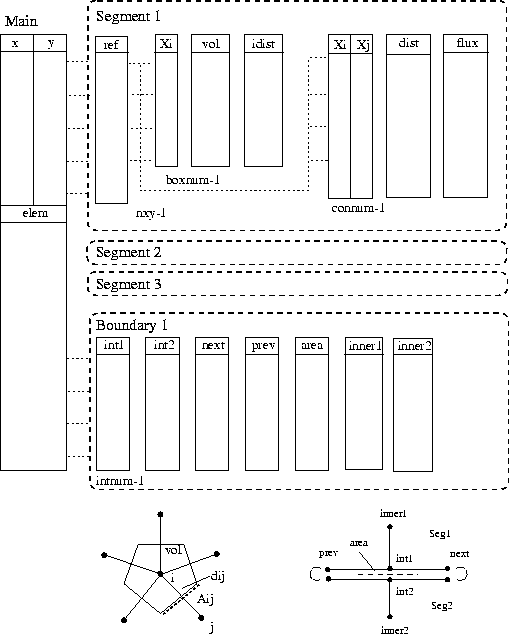



Next: 4.2.2 Assembling the Diffusion
Up: 4.2 Design of a
Previous: 4.2 Design of a
Grid generation and grid handling play key roles for the successful
numerical simulation of the diffusion problem. The grid module should be
able to handle structured (ortho-product) as well as unstructured grids.
Initially, the grid module reads the input grid information, if specified
by the user, or generates a new grid, if none specified. Thereby the
simulation topology and the grid type is evaluated and if both are matching
the incoming grid is read into the internal structures. The initial grid
must be a Delaunay mesh (cf. 4.1.1) due to the box
integration method. If no initial grid is specified by the user, we use
built-in grid generators to obtain the initial grid including mesh
refinement to resolve the input quantities by the generated grid.
Then this initial grid is partitioned into segment and boundary grids as
shown in Figure 4.2-3 to apply different model on each
partial grid. Thereby the global point-list and the global element-list of
the overall grid is stored in the Main-array. Now, the ref-array of each
partial grid contains the grid points which belong to them.
The geometry information which is obtained from each segment grid can be
classified as follows:
- Grid node information:
-
- -
- Grid node coordinates

- -
- Grid node number boxnum
- -
- Box volume related to grid node vol
- -
- Distance from grid node to nearest material interface idist
- Grid line information:
-
- -
- Grid line coordinates

- -
- Grid line number connum
- -
- Grid line length from
 to
to  (dist)
(dist)
- -
- Ratio of flux area to line length
 (flux). This
information is used for the discretization of the diffusion current models.
(flux). This
information is used for the discretization of the diffusion current models.

Figure 4.2-3: Internal
representation of segment and boundary grids in PROMIS-NT obtained
from the input or generated overall grid.
If the segment grid information is attained, the boundary grid information
structure has to be extracted from the overall grid and the previously
obtained segment grids. The boundary grids are used to connect the segment
grids at the material interface and for the setup of material interface
models (see Section 4.4).
The geometry information acquired from the boundary grids is related to the
boundary point pair int1 - int2:
- Boundary point pair information:
-
- -
- Boundary point pair coordinates

- -
- Number of boundary point pairs intnum
- -
- Distance to next point pair along the boundary (next)
- -
- Distance to previous point pair along the boundary (prev)
- -
- Interface area related to boundary discretization box (area)
- -
- For some sophisticated boundary conditions (cf.4.1-21) the
distance to next inner segment points on either side of the boundary is
obtained (inner1,inner2)
Due to the segment and boundary grids it is possible for the following
discretization routines to be independent from any structural grid
information. Complicated grid neighboring information is maintained in
several auxiliary arrays.




Next: 4.2.2 Assembling the Diffusion
Up: 4.2 Design of a
Previous: 4.2 Design of a
IUE WWW server
Wed Jul 10 16:10:00 MET DST 1996


 to
to  (dist)
(dist)
 (flux). This
information is used for the discretization of the diffusion current models.
(flux). This
information is used for the discretization of the diffusion current models.
